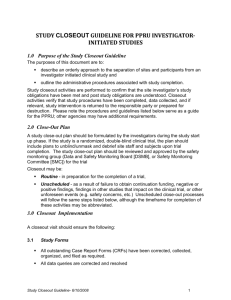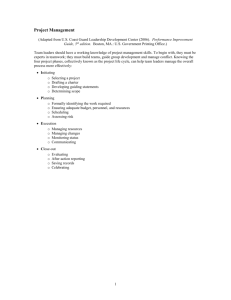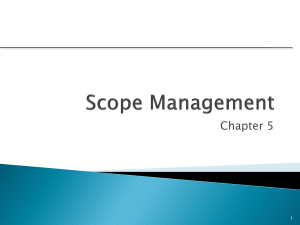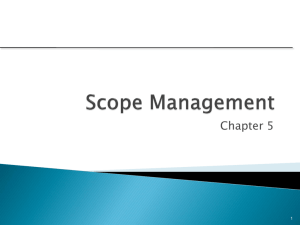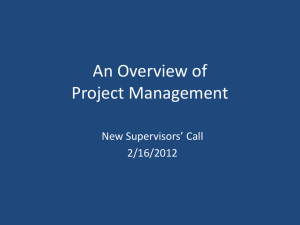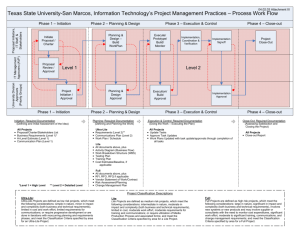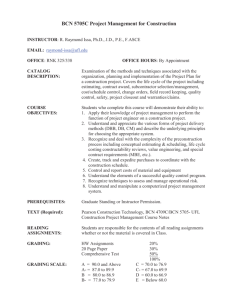Project Close-Out Guidelines: Best Practices & Requirements
advertisement
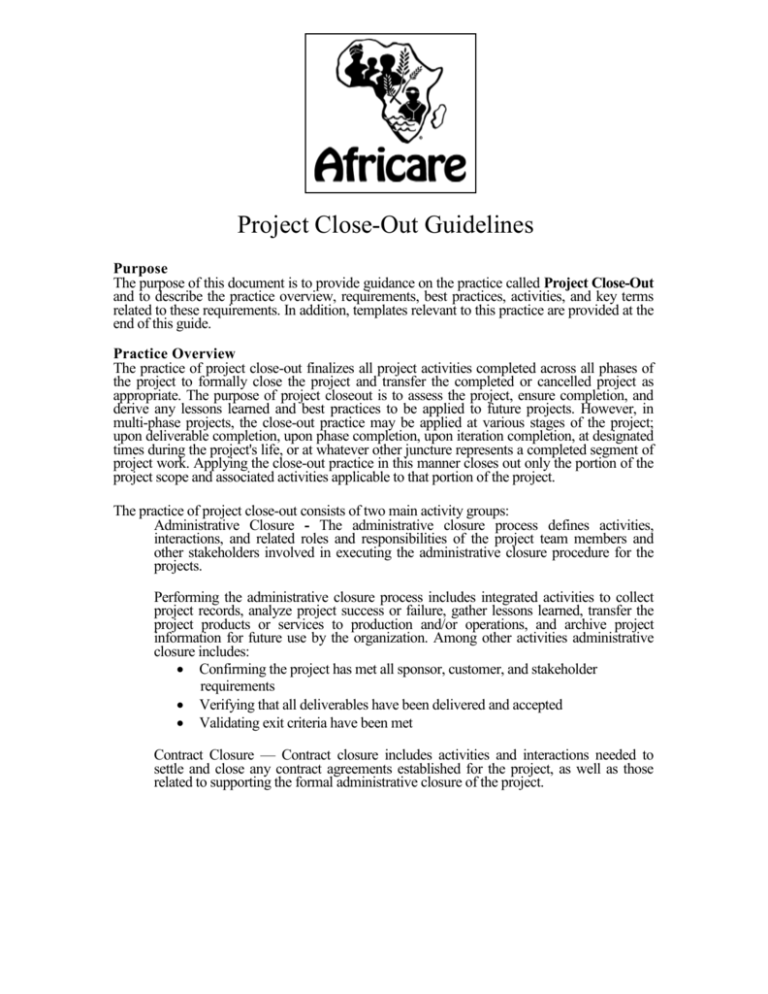
Project Close-Out Guidelines Purpose The purpose of this document is to provide guidance on the practice called Project Close-Out and to describe the practice overview, requirements, best practices, activities, and key terms related to these requirements. In addition, templates relevant to this practice are provided at the end of this guide. Practice Overview The practice of project close-out finalizes all project activities completed across all phases of the project to formally close the project and transfer the completed or cancelled project as appropriate. The purpose of project closeout is to assess the project, ensure completion, and derive any lessons learned and best practices to be applied to future projects. However, in multi-phase projects, the close-out practice may be applied at various stages of the project; upon deliverable completion, upon phase completion, upon iteration completion, at designated times during the project's life, or at whatever other juncture represents a completed segment of project work. Applying the close-out practice in this manner closes out only the portion of the project scope and associated activities applicable to that portion of the project. The practice of project close-out consists of two main activity groups: Administrative Closure - The administrative closure process defines activities, interactions, and related roles and responsibilities of the project team members and other stakeholders involved in executing the administrative closure procedure for the projects. Performing the administrative closure process includes integrated activities to collect project records, analyze project success or failure, gather lessons learned, transfer the project products or services to production and/or operations, and archive project information for future use by the organization. Among other activities administrative closure includes: Confirming the project has met all sponsor, customer, and stakeholder requirements Verifying that all deliverables have been delivered and accepted Validating exit criteria have been met Contract Closure — Contract closure includes activities and interactions needed to settle and close any contract agreements established for the project, as well as those related to supporting the formal administrative closure of the project. Contract closure involves verification that all work has been completed correctly and satisfactorily, updating of contract records to reflect final results, and archiving information for future use. Among other activities contract closure includes: Confirming the project has addressed the terms and conditions of the contracts Confirming completion of exit criteria for contract closure Formally closing out all contracts associated with the completed project Project close-out should be anticipated and planned as early as possible in the project lifecycle even though it is often the last major process of a project's life. Project closeout is critical, yet for one reason or another, it's an area that's often left loose at the ends - with the potential for disastrous consequences. Professionals who closeout properly create significant benefits for themselves, their organization and for others - better success prospects for future projects, increased employee motivation, better customer relations, improved attractiveness to repeat and new business and so on... General Guidance To ensure the timely and orderly closeout of Title II programs, CSs: Should familiarize themselves with closeout-related references and key provisions, as set forth in Sections 3 and 4 below. Should incorporate closeout management functions and responsibilities, relevant.costs, and other closeout activities into the original program proposal and, per the guidance, keep USAID/Food for Peace (FFP) informed of any potential closeout difficulties during the life of the activity (LOA). Should begin closeout preparation no less than 6 months prior to the end of the agreement for Development Activity Programs (DAPS) and Multi-Year Assistance Programs (MYAPs), and 3 months for Single-Year Assistance Programs (SYAPs). An exit or sustainability strategy should be developed before this time to ensure that its recommended plans of action, activities, and resource transfers/disposition requests are captured within the Closeout Plan itself.' To best do so, CSs should coordinate with their FFP/W and Mission/regional office on all stages of the closeout process. Must submit a detailed list of activities, inventory for disposition, action items and expenses (with a budget and a narrative) and property disposition plan related to closeout in a Closeout Plan to be submitted to FFP/W. This applies to all CSs implementing DAPs, MYAPs and/or SYAPs, as set forth in Section 7.111 below. The World Food Programme (WFP) is exempt from this guidance. Must communicate regularly with FFP/W and the relevant Mission/regional office to complete all closeout actions, including any outstanding claims or vouchers, as stipulated in the Closeout Plan and U.S. Government (USG) regulations until they have met all remaining obligations to USG. Practice Activities Convene a meeting with project leadership, project managers and appropriate team members Discuss activities on the closeout checklist Assign leads to relevant activities to make sure the closeout activity is completed Conduct a post-project survey Compile a close-out report showing final status of deliverables, issues, changes, risks, costs, etc. Consider rolling unresolved issues and changes into the next phase of the project or into a new project Obtain final, formal approvals on deliverables Conduct formal contract close-out Conduct formal administrative closure Remove sensitive information from computers and project work areas Return borrowed equipment Perform configuration audit Reassign remaining project staff to other assignments Conduct project audit Conduct post-project training for project team, customers, and/or operations team Regulatory close-out requirements Conduct lessons learned review meeting Conduct a client wrap-up meeting or project close-out meeting SUMMARY ON CLOSE-OUT: 1) Provide a brief summary of why the project is being suspended/terminated and the implications, if any, for the country and Title II beneficiaries, the project, and the CS's in-country operations. 2) Provide a brief summary of resources provided over the life of the project by USAID, the CS, the host government, other donors and beneficiaries. Also briefly summarize the sectors supported, and the location in the country where investments were made. 3) Provide a brief summary (by component if relevant) of where the project is at this point in meeting its stated goals and objectives, and where it will be at the date of close out. 4) State whether there have been any recent audits of the project (or will be) and the status of resolving outstanding audit recommendations. Attach a copy of the audit to the close-out plan or send separately to the USAID Mission and BHR/FFP (if this has not already occurred). 5) State whether there have been (or will be) a final or impact evaluation of the project. If it has been completed, attach a copy of the evaluation to the close-out plan or send separately to the USAID Mission and BHR/FFP (if this has not already occurred). If an evaluation has not been completed but is planned, discuss briefly plans to carry out the evaluation and if possible, attach the evaluation Scope of Work (SOW). I. LESSONS LEARNED: Provide a brief summary of lessons learned from the project that might be relevant to design, implementation and evaluation of other Title II projects, either in the present country or others. II. CLOSE-OUT SCHEDULE: Provide a detailed implementation plan and schedule for closing out the project that details the disposition of property and equipment; the termination of staff; the finalization of all audits, evaluations and required reports; the settling of claims; and other critical activities. III. FINAL REPORTS: Provide any reports (e.g. final report, Annual Results Report, Final Evaluation) required either in the project agreement, or in writing by USAID. IV. DISPOSITION OF COMMODITIES, ASSETS, EQUIPMENT, AND FUNDS: 1) Commodities: Prior to the project completion date, all commodities should be distributed to the intended recipients. If this is not possible, the CS should propose an alternative solution, and advise the Mission and BHR/FFP of the quantities, location and condition of the food. 2) Non-expendable property/equipment procured through Section 202(e), monetization or other USAIDprovided funds: The close-out plan should include an inventory of all non-expendable property/equipment procured with funds provided by USAID, or obtained through a monetization of Title II commodities with a unit acquisition cost exceeding $5000, and with a useful life estimated to exceed two years. The CS should describe how it proposes to dispose of each piece of property and what will be done with the proceeds if the items are sold. (Note: for additional information on and definitions of non-expendable property/equipment (as defined by the U.S. Government), please check OMB Circular 110, Subpart A and/or USAID's 22CFR, sections 226.2, 226.34 and 226.71). 3) Monetization-Generated Local Currency and Program Closeout Administration Return all personnel loaned to project Complete personnel performance evaluations Closeout Contracts Ensure that all open issues are resolved with the customer Return or destroy all customer's proprietary documents at the customer's direction Help the customer conduct an audit of completed scope When the customer is happy, receive final payments Conduct a Lessons Learned Review Conduct a survey Hold the lessons learned meeting Build a Project History File Document planned & actual schedule duration and include data on past similar completed projects Document planned & actual labor costs and include past data Document all approved changes to PM plan Document all meetings minutes Document all problems Document subcontractor performance records Document customer satisfaction records Document project reviews Create the Final Project report Describe the overall success of the project Describe organization on the project Describe recommended changes for other similar projects Describe techniques used to get results Describe project strengths & weaknesses Describe project team recommendations Celebrate Success Involve everyone on the project Gather outside the working environment Recognize outstanding performers Conduct Post-Project Assessment and Lessons Learned In addition to communicating the closure of a project in writing, it is also advisable to have a mechanism for group review & assessment of the project. Lessons learned should draw on both positive experiences— good ideas that improve project efficiency or save money, and negative experiences— lessons learned only after an undesirable outcome has already occurred. Lessons learned sessions are a valuable closure mechanism for team members, regardless of the project's outcome. The lessons learned session is typically a meeting that includes: Project team Stakeholder representation including external project oversight, auditors, and/or QA Executive management Maintenance and operations staff Project support staff Participants in lessons learned sessions typically discuss questions similar to the following: Did the delivered product meet the specified requirements and goals of the project? Was the customer satisfied with the end product(s)? If not, why not? Where costs budgets met? If not, why not? Was the schedule met? If not, why not? Were risks identified and mitigated? If not, why not? Did the project management methodology work? If not, why not? What could be done to improve the process? What bottlenecks or hurdles were experienced that impacted the project? What procedures should be implemented in future projects? What can be done in future projects to facilitate success? What changes would assist in speeding up future projects while increasing communication? Lessons learned and comments regarding project assessment should be documented, presented, and openly discussed with the intent of eliminating the occurrence of avoidable issues on future projects. Project Close-out Checklist Project Name: Project Number: Modification Dates: Date: Agency: Prepared by: Item 1 Post Implementation Evaluation Report (PIER) 2 Archive Project Information 2.2 Archive information in project repository. 3 Financial Closure Status Comments Best Practices The following approaches are recommended best practice to project close-out: Involve Stakeholders - Involve all project participants and stakeholders in the close-out process. Use a Checklist - Review the close-out checklist template to make sure all key items have been completed. Solicit Feedback - Conduct a post-project survey to solicit feedback on the project from the project team, customers, and stakeholders who were well-acquainted with the management of the project. Identify Lessons Learned - Convene a lessons learned session to promote the success of future projects. Archive Data - Archive all project data in a central repository. Include best practices, lessons learned, and any other relevant project documentation. Formal data archives should be stored in compliance with US National Archives and Records Administration (NARA) regulations. Celebrate - Celebrate and reward project success. Phased Close-Out - The project closing process is generally phased over a period of time, rather than being a single event. Depending on the project type, project close out can begin as deliverables are completed, iterations/phases closed, or at the end of the project. The project manager must ensure that the sponsor and steering committee understand and support the project closing process to reduce final project implementation risks. Manage Resources - The project manager may face requests to release staff from the project team before all project closing tasks are finished. The project manager should anticipate these requests, considering both project goals and staff capabilities. Confidentiality - Upon closing subcontractor contracts, consider the confidentiality of the contracts before potentially sharing with the client. Close Procedures (a) Recipients shall submit, within 90 calendar days after the date of completion of the award, all financial, performance, and other reports as required by the terms and conditions of the award. The Federal awarding agency may approve extensions when requested by the recipient. (b) Unless the Federal awarding agency authorizes an extension, a recipient shall liquidate all obligations incurred under the award not later than 90 calendar days after the funding period or the date of completion as specified in the terms and conditions of the award or in agency implementing instructions. (c) The Federal awarding agency shall make prompt payments to a recipient for allowable reimbursable costs under the award being closed out. (d) The recipient shall promptly refund any balances of unobligated cash that the Federal awarding agency has advanced or paid and that is not authorized to be retained by the recipient for use in other projects. OMB Circular A-129 governs unreturned amounts that become delinquent debts. (e) When authorized by the terms and conditions of the award, the Federal awarding agency shall make a settlement for any upward or downward adjustments to the Federal share of costs after closeout reports are received. (f) The recipient shall account for any real and personal property acquired with Federal funds or received from the Federal Government in accordance with Sections . 3 1 through . 3 7 . (g) In the event a final audit has not been performed prior to the closeout of an award, the Federal awarding agency shall retain the right to recover an appropriate amount after fully considering the recommendations on disallowed costs resulting from the final audit. .72 Subsequent adjustments and continuing responsibilities. (a) The closeout of an award does not affect any of the following. (1) The right of the Federal awarding agency to disallow costs and recover funds on the basis of a later audit or other review. (2) The obligation of the recipient to return any funds due as a result of later refunds, corrections, or other transactions. (3) Audit requirements in Section . 2 6 . (4) Property management requirements in Sections .31 through .37. (5) Records retention as required in Section .53. (b) After closeout of an award, a relationship created under an award may be modified or ended in whole or in part with the consent of the Federal awarding agency and the recipient, provided the responsibilities of the recipient referred to in paragraph .73(a), including those for property management as applicable, are considered and provisions made for continuing responsibilities of the recipient, as appropriate. .73 Collection of amounts due. (a) Any funds paid to a recipient in excess of the amount to which the recipient is finally determined to be entitled under the terms and conditions of the award constitute a debt to the Federal Government. If not paid within a reasonable period after the demand for payment, the Federal awarding agency may reduce the debt by (1), (2) or (3). (1) Making an administrative offset against other requests for reimbursements. (2) Withholding advance payments otherwise due to the recipient. (3) Taking other action permitted by statute. (b) Except as otherwise provided by law, the Federal awarding agency shall charge interest on an overdue debt in accordance with 4 CFR Chapter II, "Federal Claims Collection Standards."
